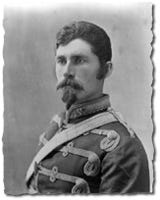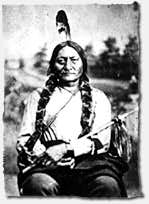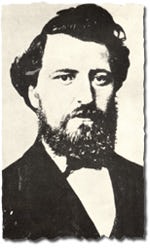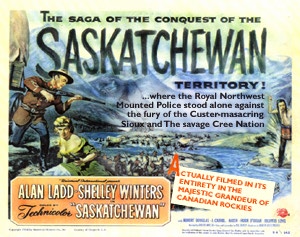

by Paul Yanko
 |
| - Photos courtesy
the RCMP Heritage Centre, Regina |
| Major James
Walsh |
Note: the RCMP Centennial Museum is now closed. It has been replaced by the RCMP Heritage Centre.
The athletic, steely-eyed white man with a red coat and an outstretched
hand struck Sioux Chief Sitting Bull as a brave person, indeed.
Accompanied by only six men, this white man had just "dropped in"
on the chief's 1,000-warrior encampment demanding an audience with
the most powerful and feared Indian on the North American continent,
the chief who one year earlier defeated Custer at the 1876 Battle
of Little Big Horn.
Sitting Bull was curious. He shook hands with the white man. Then,
through a translator, he listened attentively as Maj. James Walsh,
of the North-West Mounted Police, proceeded to tell him he's welcome
to stay in Canada so long as he obeys the laws of the land.
"People who break laws in this land, whether they be whites, blacks
or browns, will not escape punishment," Walsh said.
Sitting Bull paused, and then laughed at the ridiculous situation:
A man with six followers telling a powerful chief with a thousand
braves what he must do? Yet, according to Sitting Bull biographer
Grant MacEwan, the chief agreed with Walsh's request to meet with
the Sioux council for a full briefing on Canadian laws.
 |
| Chief
Sitting Bull |
In the four years Sitting Bull lived in what is now Saskatchewan,
he came to respect and trust Walsh more than any other white man
he knew. The respect was mutual.
And while the two strong-headed men engaged in heated arguments
at times, the most important chief in North America soon came to
realize Walsh and his "redcoats" were true to their word: They enforced
the law equally among all residents of the West.
It was no easy task. Violence was escalating in some areas of the
Canadian West, and the remainder was a tinderbox waiting for a match.
In 1870, the fledgling Canadian government purchased a large parcel
of western land from the Hudson's Bay Company, with the intention
of encouraging settlement in the region.
In what's now Saskatchewan and Alberta, the government sought to
place peaceful homesteaders on farms. Instead, whiskey traders and
bandits made murder and drunkenness the order of the day.
"Here large numbers of reckless men found their way, and simply
did what they pleased, ruined the Indians, and brought on quarrels
with them for the sake of gain," Samuel Steele, a founding member
of the force, wrote in his autobiography.
In Manitoba, which borders Ontario, there was armed rebellion in
1870 by Metis people (French-Canadian and Indian blood) fighting
for land rights. Meanwhile, well before Sitting Bull arrived, "American"
Indians were fleeing the "Indian Wars" south of the border to take
refuge, and perhaps incite violence, among their Canadian counterparts.
The final straw came in May, 1873, in the Cypress Hills area of
what is now southwestern Saskatchewan, when a band of white "wolfers"
from the United States and Canada massacred several dozen Assiniboia
Indians over the alleged theft of horses.
"The massacre of so many of our aboriginal people at Cypress Hills
accelerated the organization and dispatch of the North-West Mounted
Police to the western frontier," says Dr. Bill Beahen, RCMP historian.
"The Canadian government was determined that this police force would
protect the western tribes from the violence which accompanied the
settlement of the American frontier."
The North-West Mounted Police, as it was originally known, was
born August 30, 1873, the result of a bill introduced in the Canadian
House of Commons. (The force was conferred its "Royal" designation
by King Edward VII in 1904, and became the Royal Canadian Mounted
Police in 1920.)
It was the beginning of a world-famous force whose men in red came
to symbolize a nation. Their stories are the drama and adventure
that was the taming of the Canadian frontier. And their history
comes to life at the RCMP Centennial Museum, located at the force's
training depot in Regina.
"We've got more than 30,000 artifacts valued at about 25 million
dollars," says curator William MacKay. Even with a sprawling 1,300
square metres of floor space, he adds, only a fraction are on display
at any given time.
 |
| An
angry encounter with government land surveyors in 1869 helped
establish Louis Riel as the leader of the Metis people. |
Central among the these are the artifacts and documents relating
the tale of Metis leader Louis Riel, a pivotal and still controversial
figure in western Canadian history.
After leading Manitoba's Red River Rebellion in 1870, Riel was
forced into exile in the United States. He was invited back to Canada
in 1884 by Metis seeking land and legal status in an area that's
now in Saskatchewan. Frustrated by government inaction on the issues,
Riel in 1885 declared a provisional government at Batoche, about
75 kilometres northeast of present-day Saskatoon, Saskatchewan.
Fighting broke out a week later at Duck Lake when a small NWMP
force of about 100 men, some of them volunteers, went up against
the Metis and lost. This sparked the government to mobilize the
Canadian Militia. The Metis, joined by disgruntled and starving
Indians, fought well under the brilliant guerrilla-warfare tactics
of Metis military commander Gabriel Dumont. But on May 12, 1885,
they lost a decisive battle at Batoche and the rebellion was over.
Riel was captured on May 15, tried in Regina and convicted of treason,
and hanged in November.
Until recent years, this still-reverberating affair was known as
"The Riel Rebellion". Many newer publications now refer to it as
"The North-West Resistance". And many non-aboriginal Canadians are
reviewing their assumptions about Riel from a modern-day vantage
point.
"I take a little more time each time I'm here, and I always find
something new," says John Hettema, a Regina man who was touring
the museum with his wife and their friend from France. "Louis Riel
must have been reasonably well-educated to have written the way
he did -- that always impresses me."
Hettema's French friend, 55-year-old Jeanette Brissieux from Lorient,
Brittany, adds: "It's very interesting to see how difficult it has
been to build Canada."
Nearby is a tale that made headlines around the world in 1932.
 |
| Even
wearing his snowshoes backwards didn't thwart the RCMP who,
for the first time, used an aircraft to help track their suspect. |
"Mad Trapper" Albert Johnson was thought to be illegally trapping
on Indian land.
An RCMP constable was dispatched to his remote location in the
Northwest Territories to investigate and, before words were exchanged,
Johnson fired on the officer through the door of his makeshift shack.
The injured officer managed to get away and, after a second patrol
engaged Johnson in a lengthy gun battle 10 days later, he fled into
the wilderness. One of the most famous manhunts in history was underway.
"This thing was the media event of its time," says Malcolm Wake,
former director of the museum. "We had this big case going on in
the Great Canadian North. We had the Mounties and we had the Mad
Trapper. This story was being told around the world. In its day,
it would have been the equivalent of the O.J. Simpson trial."
The manhunt lasted a month and a half before Johnson, who had been
wearing his snowshoes backwards to confuse his pursuers, was shot
and killed in a gun battle with police. To this day, no one is sure
of his identity or how he came to be in possession of $2,400 -- a
princely sum in those days. But from that point on it was clear
to the world: The RCMP always get their man.
The museum even covers the RCMP's role in Hollywood films of the
30s, 40s and 50s. One of many movie posters included in the memorabilia
is one promoting Cecil B. DeMille's 1954 production of "Saskatchewan",
starring Alan Ladd and Shelley Winters. The poster boasts, somewhat
humorously to anyone familiar with Canadian geography, the movie
was "actually filmed in the Canadian Rockies!"

|
|
During
the 1930's, so many movies were being made about the RCMP
that officers were sent to Hollywood to act as technical advisors.
|
"We also collect the funnier stuff, too," says MacKay. "We try
to collect any artifact pertinent to the Mounted Police. My motto
is "collect today for tomorrow'."
While the RCMP museum is the highlight for visitors, there's much
more to see at "Depot" Division.
The force trains an average of 500 cadets here each year. Training
lasts six months and includes extensive classroom study in subjects
such as law, firearms and cross-cultural understanding.
Visitors participating in the 45-minute tour of the training facility
are sure to encounter cadets marching in formation or jogging at
brisk pace down one of the base roads. Some 46,000 RCMP officers
have been trained here since 1885.
They'll also see (from the outside, only) the forensic lab, established
in 1937 but replaced in 1995 with a state-of-the-art facility. Here,
the force employs scientists working in a dozen fields ranging from
counterfeit detection, chemistry and firearms, to blood stain analysis
and toxicology.
 |
| Originally
constructed to serve as a mess hall, the chapel was converted
to its present role in 1895 after it was nearly destroyed by
fire. |
One of the most photogenic stops on the tour is the RCMP Chapel.
Built in 1883, it's Regina's oldest structure and a quaint symbol
of the rectitude all officers are expected to carry with them into
the field.
Tip: If you plan to be in Regina during July or August,
set aside Tuesday evening for a once-per-week event that's ranked
as one of the top 100 tourist attractions in North America: the
Sunset Retreat Ceremony.
Based on British military tradition dating back to the 19th century,
the 45-minute ceremony features a troop drill display, cadet choir,
and the lowering of the flag in conjunction with the playing of
the retreat.
There is no charge to attend.
The museum charges no admission, but donations are gratefully
accepted. Guided tours of the training academy occur only during
week days.
During the summer (June 1 to September 15) the museum is open
from 8 a.m. to 6:45 p.m. In the winter months, its hours are 10
a.m. to 4:45 p.m. For further information, contact the RCMP Centennial
Museum at 306-780-5838, or check out the website.
Contact Us
| Contents |
Advertising
| Archives
| Maps
| Events | Search |
Prints 'n Posters | Lodging
Assistance | Golf |
Fishing |
Parks |
Privacy |
© Copyright (1997-2007) Virtual Saskatchewan
|

